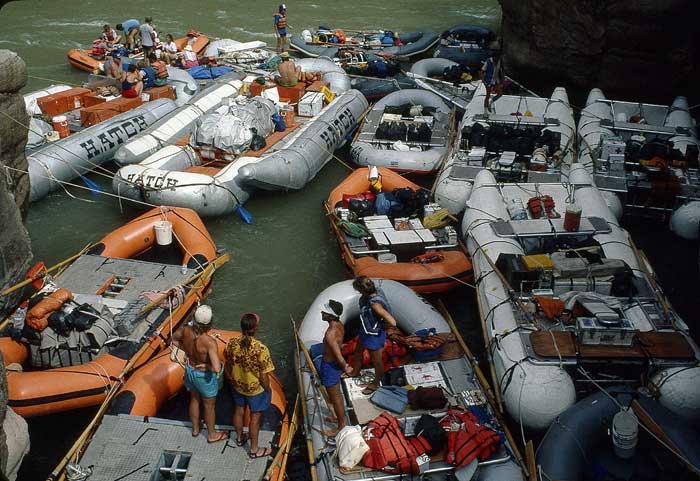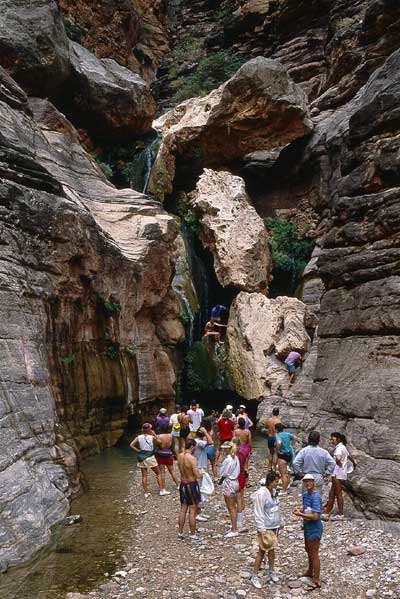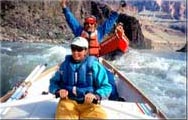Grand Canyon Region
AWC Regions: Grand Canyon | Western Desert | Central Mountains/Sonoran | Sky Island
Accessibility | Crowding
and Congestion | Concession Services | Self-Guided
Trips | Safety-Ability | Trip
Length | Chart Comparison
One of the greatest natural wonders on Earth...
...should be protected with our greatest conservation tools.
Yet the Grand Canyon and its wild Colorado River are facing an uncertain
future.
Running the Grand Canyon by boat has turned into an amusement ride in the world's largest theme park. The National Park Service continues to ignore its obligation to protect wilderness values in favor of commercial boating interests who run fast, noisy, crowded motor boats down the river to maximize profits. 
Protected as federal wilderness, the untamed, natural wonders of the
Grand Canyon would reign supreme--by restoring one of the most awesome river
experiences in the United States, and by protecting the ecological resources that classify Grand Canyon as a crown jewel in our National Park System.
The Arizona Wilderness
Coalition supports wilderness for Grand Canyon National Park that includes
the Colorado River corridor.
Below is a list of concerns
addressed by our Conservationists' Wilderness River Proposal, which addresses many of the concerns expressed by the park, commercial boating interests, and the general public.
Click here to see a chart comparison between current river conditions and our wilderness resolution.
Accessibility
Our wilderness proposal gives the same number of people the opportunity
to take commercially operated tours each year, with the benefit of smaller,
more personalized trips (20 as opposed to 40) and fewer encounters with
other groups. 
Crowding and Congestion
Our wilderness proposal would reduce the current crowding and degradation
to vegetation and beaches by reducing group size and spreading out use
into the loveliest time of year on the river - late spring and early fall.
The result would be a halcyon retreat from the pace and pressure of urban
life.
Concession Services
Our wilderness proposal retains concession services for those without
the experience or desire to run the river on their own and can afford
these expensive vacations. It simply shifts the allocation to non-motorized
boats. Moreover, our proposal urges the National Park Service to expand
the type of commercial services offered on the river to those that would
allow more passenger participation and cost less.
 Self-guided
Trips Self-guided
Trips
Our wilderness proposal corrects the imbalance in allocation between
commercial trips and those river-runners who don't need or can't afford
such a service. It would double the number of folks who could take self-guided
trips and reduce the enormous backlog of people who are now waiting as
much as 20 years to get on the river.
Safety and Ability
Commercial oar-powered trips are the safest type of river trip - two
independent studies have confirmed that. Professional guides on oat boats,
responsible for four people rather than up to 18 on motor rigs, can accommodate
passengers at all levels of physical fitness and ability. Passengers need
only sit back, hold on occasionally and enjoy the delights of the canyon.
On oar trips guides needn't yell over the noise of the motor; they can
share their knowledge of the canyon and get to know their passengers better,
thus providing more individualized service both on and off the river.
Trip Length 
Our wilderness proposal gives folks the choice to take a trip through
the entire length of the canyon in 12 to 16 days, or a 4-5 day trip through
the narrow upper reaches of the canyon and hike or ride a mule out on
the popular Bright Angel trail. It is also possible to join a trip at
this point and spend a week on the expansive lower portion of the canyon.
Both are equally spectacular, and offer many fascinating side trips that
folks miss on the current motorboat tours that race through the canyon.
|

